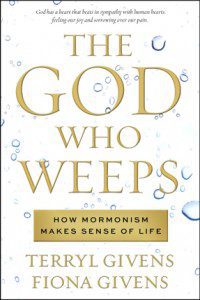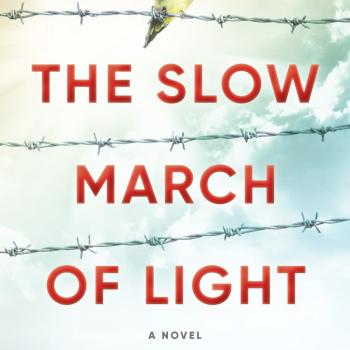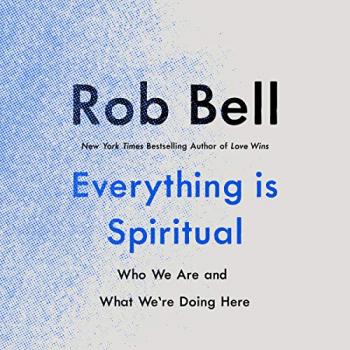 In the midst of the so-called “Mormon Moment” in our country, a new Pew Research Center poll out this week reports that 8 in 10 Americans say “they learned little or nothing about the Mormon religion during the 2012 presidential election” (even while there was some “warming of attitude toward Mormonism”). With the release of a new book, The God Who Weeps: How Mormonism Makes Sense of Life, two scholars, who also happen to married, hope to turn the tide on this national mis-education about their beloved religion and tell of “a God whose heart beats in sympathy with ours…”
In the midst of the so-called “Mormon Moment” in our country, a new Pew Research Center poll out this week reports that 8 in 10 Americans say “they learned little or nothing about the Mormon religion during the 2012 presidential election” (even while there was some “warming of attitude toward Mormonism”). With the release of a new book, The God Who Weeps: How Mormonism Makes Sense of Life, two scholars, who also happen to married, hope to turn the tide on this national mis-education about their beloved religion and tell of “a God whose heart beats in sympathy with ours…”
Dr. Terryl Givens is a Professor of Literature and Religion at the University of Richmond and the author of several highly-acclaimed books. Fiona Givens is recently retired from directing the French Language program at Patrick Henry High School in Ashland, VA. This book is their first coauthorship. We invited the Givens to share why they were compelled to write this book, now, and what they most hope people take away from it.
What do you hope to accomplish with this book?
 The last several years have seen a steady stream of news articles and television coverage of Mormonism. Cable TV shows and Broadway musicals have added to the barrage of representations of who Mormons are and what they believe. The cumulative result is that Mormonism suffers a public image predicament similar to the Amish media-purgatory of simplistic horse and buggy caricatures. We wanted to move beyond the peripheral, the odd, the sensational, and reveal what is really central to Mormon belief. From the outside, one can observe the appearance, the structure, the textures and the elements that make up a Gothic cathedral like Notre Dame. But there is a deep logic, an aesthetic and emotional coherence, that is only experienced when one stands inside, where the sun’s rays illuminate the stained glass.
The last several years have seen a steady stream of news articles and television coverage of Mormonism. Cable TV shows and Broadway musicals have added to the barrage of representations of who Mormons are and what they believe. The cumulative result is that Mormonism suffers a public image predicament similar to the Amish media-purgatory of simplistic horse and buggy caricatures. We wanted to move beyond the peripheral, the odd, the sensational, and reveal what is really central to Mormon belief. From the outside, one can observe the appearance, the structure, the textures and the elements that make up a Gothic cathedral like Notre Dame. But there is a deep logic, an aesthetic and emotional coherence, that is only experienced when one stands inside, where the sun’s rays illuminate the stained glass.
Who’s your intended audience?
Reflective people, inside or outside Mormonism, who are interested in either a first or a new perspective on the faith. We aim for the many observers who sense something is radically distorted or simply incomplete in their perception of Mormons. Or for those who are curious about what might be compelling about the underlying story Mormons embrace in an attempt to put life’s pains and joys alike into a larger cosmic narrative. But we also think the book has something new to offer Mormons as well. Mormons are notoriously busy folks, attending marathon meetings, serving as lay ministers and teachers in their congregations, participating in service projects, and raising families or serving missions or doing family history. Busy-ness defines them. And when they do pause to reflect on their faith, that reflection is often prompted by superficial questions others are posing, or by the tradition’s own compelling if fraught history. We want to shift the focus to a deeper engagement with how successfully Mormonism addresses the great questions of human existence and life’s meaning, and put some of Mormonism’s answers into conversation with like-minded poets, philosophers, and theologians of the Western tradition.
What is at the core of the Mormon view of God? What’s distinctive about that view?
At the core of Mormon theism is belief in a compassionate, feeling, even vulnerable God. His appellation of Father is more than mere metaphor, and most distinctive of all is Mormonism’s espousal of a Heavenly Mother, or a Feminine Divine. The concept appears increasingly in recent reevaluations of pre-exilic Judaism, and in feminist theology. Mormonism is perhaps unique in the Christian world in taking the concept of a heavenly mother seriously as a theological proposition.
It is now common for believers and theologians alike to talk in terms of a feeling, personal, compassionate God. It is easy to forget that in 1830, the Christian world almost universally embraced a creedal position still on the books of many faiths: belief in a God “without body, parts, or passions.” Smith’s description of a Heavenly Father who literally wept over the pain of his children was a startling innovation. And Mormonism developed that cardinal insight into a God-theology that collapses the infinite divide separating Creator from creature into a bond of familial resemblance. God is a being of supreme majesty and perfection and holiness-but he is not utterly beyond our comprehension, or remote from a personal if worshipful relationship.
Your book is unconventional in several ways. Instead of focusing on the typically cited distinctive doctrines of Mormonism, you discuss cosmic questions, with scant reference to Mormon-specific scripture or authorities or contemporary worship. Why this approach?
We think the “typically cited distinctive doctrines” aren’t the most essential, or the most resonant. We wanted to move beyond a focus on the institutional, the social, the cultural and the historical aspects of Mormonism, to highlight its underlying eternal and universal dimensions. Even Mormons often miss Smith’s understanding of his mission as a modern prophet. Referring to the allegory of the woman in the wilderness, who was “nurtured of the Lord” through centuries of darkness (Revelation 12), Smith believed that the church he “restored” did not suddenly emerge from a vacuum. He taught that the fullness of truth was known to the ancients, and a more recent Mormon leader taught that when God lacked for prophets, he spoke to the poets. Every essential Mormon belief has counterparts in the ancient or contemporary world, parallels that enrich and sometimes amplify Mormon teachings—whether we are talking about a vulnerable God (who saves by his weakness, wrote Bonhoeffer), a premortal human existence (taught by Augustine, Henry More, and countless others), a more universal conception of human salvation (Origin and Charles Chauncy), or a dozen other tenets.
Some readers will finish your book and will have lots of questions about how the five propositions you discuss translate into contemporary Mormon belief and practice. Where would you suggest those readers turn to learn more?
Elsewhere we’ve tried to describe how a Mormon belief system has given shape to Mormon culture (People of Paradox); Matthew Bowman has written a good overview of The Mormon People with a splendid treatment of the contemporary church; some of the more thoughtful writers on what it means to be a Mormon disciple of Christ would include the essayist Eugene England (d. 2001), the apostle Neal A. Maxwell (d. 2004), Stephen Robinson and Robert Millet.
What was it like to co-author The God Who Weeps? What did you learn from each other? How did writing this book from a joint male/female perspective affect the tone or content or approach to your book?
Theology has always been a predominantly male enterprise. We hope our collaborative venture has produced a richer and more balanced vision of divine magnanimity, and of the divine personality as one in which emotional capaciousness is not only present but essential to the divine nature. As for our personal experience in writing jointly, the project was more a culmination and recognition of the collaborative life we have lived, than a new direction or experience.
Your book is not only an invitation to consider some of the ways “Mormonism makes sense of life.” It’s also an invitation for people from varied faith backgrounds to “reason together” about some of the Big Questions of life. In other words, the book is both very Mormon and at the same time not confessionally so. Is that a fair characterization?
Early Mormonism had a powerfully universalist impulse, manifest across several dimensions. Mormons espouse a literal familial relationship with the entire human family, and a common origin in a premortal place and time. Joseph Smith was convinced God “would ferret out” every soul that could possibly be brought to salvation, and developed a universal salvation theology accordingly. And Smith spoke of the fragments of truth scattered liberally across religions, encouraging Mormons to embrace truth wherever it could be found. In these and other ways, Mormonism is radically non-elitist, open, and cosmopolitan. That’s not the version of Mormonism many have appreciated (or that Mormons have always practiced). We hope to give renewed emphasis to that vision of Mormonism, with due appreciation to what Smith referred to as the “holy men” (and women) who live and write and worship outside the Mormon faith tradition.
During this Advent season, how would you connect the notion of the “God who weeps” with the Incarnation, the Christ-event?
Jesus Christ has long been identified by Christians as the “suffering servant” referred to by Isaiah. At Christmas time, these same Christians celebrate the miraculous incarnation of this member of the godhead, born to be “despised and rejected of men; a man of sorrows, and acquainted with grief.” We join in this celebration with whole hearts. At the same time, God’s suffering was not confined to Christ’s torments at Gethsemane and Golgotha. Compassionate suffering cannot be relegated neatly to one of God’s modes or persons. It was not just as the embodied Christ that he was “afflicted in all their afflictions.” The shadow of the cross is long enough to heal the past and anticipate the future, but God the Father does not exist outside time. He is not some cosmic ventriloquist, or a magic jack-in-the box, assuming human form once or twice a thousand years to speak, then reverting back to ineffable substance, now popping back into a human universe to interact with his creations. We may inhabit realms as different as those of fish and fowl; we may swim while he soars, and breathe a different air. But when God speaks from heaven, or his angels minister, a wing breaks the water and heaven and the sea touch. we share the same universe, the same existence that continues through time. God’s love, his vulnerability, are a permanent condition of who he is.
For more on The God Who Weeps, and to read a book excerpt, visit the Patheos Book Club here.













